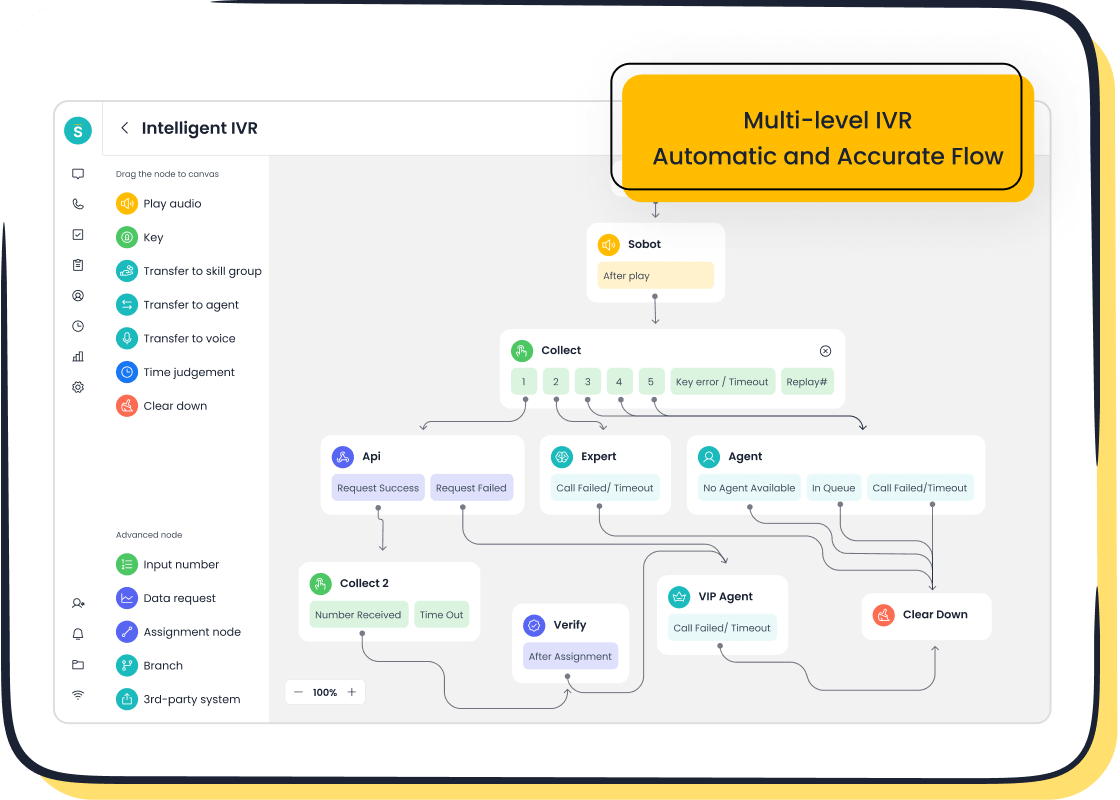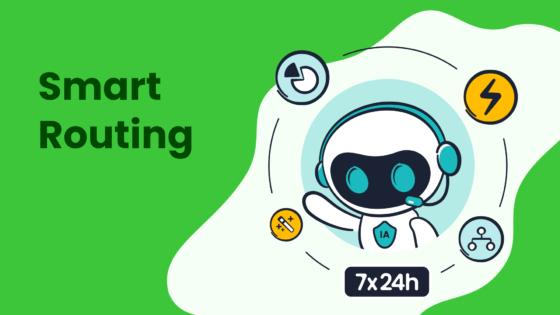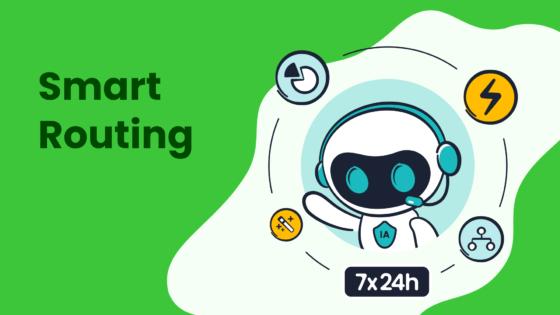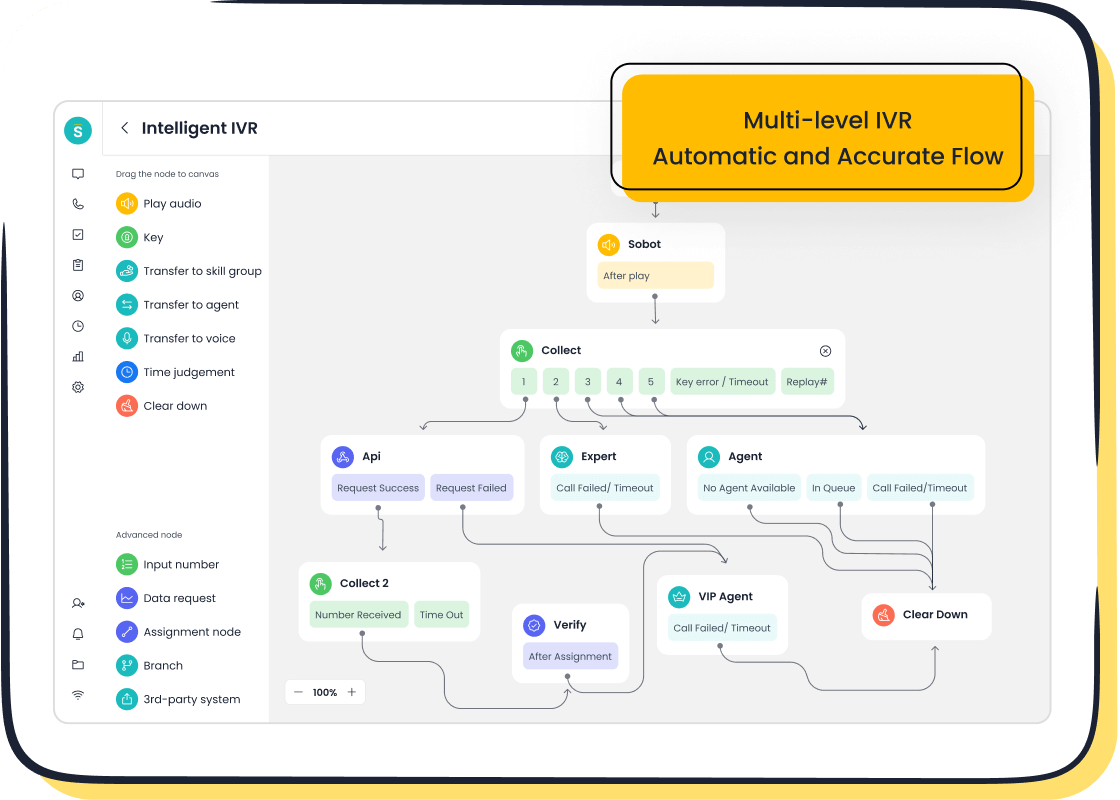Service Level Rate Integration for Better Operations

Service Level Rate (SLR) measures how well a business meets its service commitments within a specific timeframe. It plays a vital role in ensuring customer satisfaction and operational success. Businesses with defined SLRs are 50% more likely to meet customer satisfaction targets. Monitoring service levels in high-volume environments builds trust and improves response times, directly enhancing customer experiences.

Sobot offers advanced tools like its Voice/Call Center to help businesses integrate SLR seamlessly. These tools enable real-time tracking, data analysis, and efficient workflows, ensuring consistent service delivery.
Understanding Service Level Rate (SLR)

What is Service Level Rate (SLR)?
Definition and key components of SLR
Service Level Rate (SLR) measures how well your business meets predefined service commitments. It evaluates performance based on metrics like response times, resolution rates, and adherence to service agreements. SLR ensures that your operations align with customer expectations, fostering trust and reliability.
Key components of SLR include:
| Key Component | Description |
|---|---|
| Service Expectations | Specify what clients should anticipate regarding service quality and speed. |
| Performance Metrics | Quantifiable measures like uptime, response, and resolution times. |
| Responsibilities | Duties and tasks for both the service provider and the client. |
| Compensation and Penalties | Financial penalties or compensatory services in the event of SLA breaches. |
| Review Mechanisms | Processes for ongoing review and adjustment of the SLA as business needs change. |
These components help you define clear goals and measure success effectively.
Common industry standards for SLR
Different industries adopt SLR standards to maintain consistency and quality. For example:
| Industry | Adoption Rate | Active Usage Rate |
|---|---|---|
| E-commerce | High | 40% |
| SaaS | High | 40% |
| Other sectors | Moderate | N/A |
High adoption rates in e-commerce and SaaS highlight the importance of SLR in customer-centric industries. These standards ensure that your business remains competitive and meets customer demands.
Importance of Service Level Management
How SLR supports customer satisfaction
SLR plays a crucial role in enhancing customer satisfaction. Metrics like First Response Time (FRT) and Time to Resolution (TTR) directly impact how customers perceive your service. Meeting or exceeding these metrics builds trust, encouraging loyalty and advocacy. For instance, adhering to SLR commitments can improve your Customer Satisfaction Score (CSAT), a key indicator of service quality.
The role of SLR in service level management
Service level management ensures that your business consistently meets its service commitments. By monitoring SLR metrics, you can identify performance gaps and implement improvements. This proactive approach not only enhances operational efficiency but also strengthens customer relationships. For example, businesses using SLR often achieve higher SLA compliance rates, reflecting their reliability and dedication to customer needs.
Applications of SLR in Business Operations
SLR in customer service centers

In customer service centers, SLR ensures timely responses and resolutions. Metrics like SLA compliance and agent utilization help you optimize workflows and allocate resources effectively. For example, Sobot's Voice/Call Center offers tools like intelligent IVR and real-time monitoring to streamline operations, ensuring that your team meets SLR targets consistently.
SLR's impact on operational efficiency
SLR improves operational efficiency by providing clear benchmarks for performance. It enables data-driven decision-making, helping you identify bottlenecks and optimize processes. For instance, businesses that integrate SLR into their operations often see reduced average handle times and increased first-contact resolution rates. These improvements not only enhance customer satisfaction but also boost overall productivity.
Benefits of Integrating SLR into Business Operations
Enhanced Customer Satisfaction
Faster response times and resolution rates
Integrating service level rate (SLR) into your operations ensures faster response times and quicker resolutions. Customers value prompt service, especially in high-volume environments. By monitoring performance metrics like First Response Time (FRT) and Time to Resolution (TTR), you can meet or exceed expectations consistently. This approach builds trust and enhances customer satisfaction. For example, tracking Customer Satisfaction (CSAT) scores alongside SLA metrics provides a clear view of how well your team performs. Businesses that prioritize quick responses often see improved customer loyalty and retention rates.
Consistent service delivery across channels
SLR integration helps you maintain consistent service delivery across all communication channels. Whether customers reach out via email, phone, or social media, they expect the same level of quality. Tools like Sobot's Voice/Call Center unify customer interactions, ensuring seamless experiences. Maintaining high service levels across channels not only improves customer satisfaction but also strengthens your brand reputation. Consistency in service delivery is crucial for meeting customer expectations and fostering long-term relationships.
Improved Operational Efficiency
Streamlined workflows and reduced bottlenecks
SLR integration streamlines workflows by providing clear benchmarks for your team. When you set specific service level objectives (SLOs), your team knows exactly what to aim for. This clarity reduces confusion and eliminates bottlenecks in processes. For instance, Sobot's intelligent IVR system automates call routing, ensuring that customers connect with the right agents quickly. Streamlined workflows lead to faster resolutions and higher productivity, benefiting both your team and your customers.
Data-driven decision-making with SLR metrics
SLR metrics empower you to make informed decisions based on real-time data. By analyzing trends and identifying areas for improvement, you can optimize your operations effectively. Continuous monitoring of SLR performance helps you adapt to changing customer needs. Companies that use data-driven strategies often achieve higher efficiency and better results. For example, organizations that monitor SLOs regularly are 50% more likely to meet customer satisfaction targets. This proactive approach ensures that your business stays competitive and customer-focused.
Better Accountability and Transparency
Clear performance benchmarks for teams
SLR integration establishes clear performance benchmarks for your teams. These benchmarks help you measure success and identify areas for improvement. When everyone understands their responsibilities, accountability increases. For example, setting measurable KPIs aligned with SLR ensures that your team stays focused on achieving goals. Clear benchmarks also make it easier to track progress and celebrate achievements, boosting team morale.
Improved collaboration across departments
SLR fosters better collaboration by aligning goals across departments. When teams work toward shared objectives, communication improves, and silos break down. For instance, integrating SLR into your sales and marketing strategies ensures that both teams deliver consistent service. This alignment enhances efficiency and creates a unified approach to customer service. Improved collaboration not only benefits your internal operations but also enhances the overall customer experience.
Step-by-Step Guide to SLR Integration

Define Objectives and Metrics
Aligning SLR goals with business priorities
To integrate service level rate (SLR) effectively, you must align its goals with your business priorities. Start by identifying the key areas where SLR can make the most impact, such as customer service, sales, or marketing. For example, if your business focuses on improving customer retention, prioritize metrics like First Response Time (FRT) and resolution rates. These metrics directly influence customer satisfaction and loyalty. By aligning SLR with your objectives, you ensure that your efforts drive meaningful results.
Setting measurable KPIs for success
Setting measurable KPIs is essential for tracking progress. Use performance metrics like SLA compliance, agent utilization, and customer satisfaction (CSAT) to evaluate success. For instance, Sobot's Voice/Call Center provides real-time data on these metrics, helping you monitor and improve performance. Clear KPIs not only guide your team but also create accountability, ensuring everyone works toward shared goals.
Develop Service Level Agreements (SLAs)
Establishing clear expectations with stakeholders
Service level agreements (SLAs) form the foundation of effective service level management. Collaborate with stakeholders to define expectations clearly. Specify response times, resolution rates, and other key metrics. For example, an SLA might state that 90% of customer inquiries will receive a response within 24 hours. Clear expectations help you build trust and ensure consistent service delivery.
Formalizing SLAs to guide operations
Formalizing SLAs ensures that your team has a clear roadmap for operations. Use quantitative methods to measure success, such as:
| Metric | Description |
|---|---|
| First Response Time (FRT) | Measures the time taken for the service provider to respond to a customer's initial request. |
| SLA Compliance | Quantifies the percentage of tickets resolved within SLA timeframes, indicating service commitment. |
| Agent Utilization | Reflects the efficiency of agents by comparing time spent on support tasks to total available hours. |
| Customer Satisfaction (CSAT) | Assesses customer satisfaction levels following interactions with the service provider. |
These metrics provide actionable insights, helping you refine your operations and meet SLA commitments effectively.
Implement Monitoring Tools
Leveraging Sobot's Voice/Call Center for real-time tracking
Monitoring tools play a crucial role in service level management. Sobot's Voice/Call Center offers features like real-time tracking and intelligent IVR. These tools allow you to monitor call data, track SLA compliance, and optimize workflows. For example, you can use real-time dashboards to identify bottlenecks and allocate resources efficiently. This proactive approach ensures that your team consistently meets service level agreement targets.
Automating data collection and reporting
Automation simplifies the process of collecting and analyzing data. Sobot's platform automates data collection, providing detailed reports on performance metrics like agent utilization and CSAT. Automated reporting saves time and ensures accuracy, enabling you to focus on strategic improvements. Businesses that leverage automation often achieve higher efficiency and better customer outcomes.
Align SLR with Business Goals
Integrating SLR into customer service strategies
You can integrate SLR into your customer service strategies by focusing on measurable outcomes. Start by identifying the key performance metrics that align with your business objectives. For example, if your goal is to improve customer retention, prioritize metrics like First Response Time (FRT) and resolution rates. These metrics directly impact customer satisfaction and loyalty.
Using tools like Sobot's Voice/Call Center, you can track these metrics in real time. Features like intelligent IVR and automated call routing ensure that your team meets service level commitments consistently. This approach not only enhances customer experiences but also strengthens your brand reputation. Businesses that align SLR with their customer service strategies often see improved Net Promoter Scores (NPS) and reduced churn rates.
Ensuring cross-departmental collaboration
Aligning SLR with business goals requires collaboration across departments. When teams like sales, marketing, and customer service work together, they can deliver a unified customer experience. For instance, your marketing team can use SLR data to identify trends and tailor campaigns, while your sales team can leverage this information to address customer pain points effectively.
Sobot's unified platform facilitates this collaboration by integrating customer interactions across channels. This integration ensures that all departments have access to the same data, enabling seamless communication and coordination. Cross-departmental collaboration not only improves operational efficiency but also helps you achieve your service level management objectives.
Conduct Regular Reviews and Improvements
Analyzing SLR performance data
Regularly analyzing SLR performance data is crucial for maintaining high service standards. Use tools like Sobot's real-time dashboards to monitor metrics such as SLA compliance and agent utilization. These insights help you identify areas for improvement and make data-driven decisions.
For example, if your analysis reveals a drop in SLA compliance, you can investigate the root cause and implement corrective measures. Businesses that consistently review their performance data often achieve higher efficiency and better customer outcomes.
Adapting strategies based on findings
Adapt your strategies based on the insights gained from performance data. If you notice that certain channels, like email or social media, are underperforming, consider reallocating resources or implementing new tools to address these gaps. For instance, Sobot's omnichannel solutions can help you optimize workflows and improve service delivery across all platforms.
Continuous improvement is key to staying competitive. By regularly updating your strategies, you can ensure that your business meets evolving customer expectations and maintains its edge in the market.
Overcoming Challenges in SLR Integration
Common Challenges
Resistance to change within teams
Resistance to change is one of the most common challenges when integrating Service Level Rate (SLR). Team members may feel overwhelmed by new processes or fear that automation could replace their roles. For example, introducing tools like Sobot's Voice/Call Center might initially seem intimidating to employees unfamiliar with advanced technology. This resistance can slow down the adoption process and impact overall efficiency.
Lack of clear metrics or benchmarks
Without clear metrics or benchmarks, it becomes difficult to measure success. Teams may struggle to understand what they are working toward. For instance, if your business lacks defined Key Performance Indicators (KPIs) like First Response Time (FRT) or SLA compliance, tracking progress becomes nearly impossible. This lack of clarity can lead to inconsistent service delivery and hinder effective problem management.
Solutions to Challenges
Training employees on SLR importance
Training is essential to overcome resistance to change. Educate your team about the benefits of SLR, such as improved customer satisfaction and operational efficiency. Use real-world examples to demonstrate how tools like Sobot's Voice/Call Center simplify workflows and enhance productivity. For instance, show how intelligent IVR systems reduce manual tasks, allowing employees to focus on complex issues. Training sessions should also emphasize the role of SLR in it service management, helping employees see its value in achieving business goals.
Using pilot programs to test integration strategies
Pilot programs provide a low-risk way to test SLR integration strategies. Start with a small team or department to identify potential challenges and refine your approach. For example, you could implement Sobot's real-time monitoring tools in one customer service center before scaling up. This method allows you to gather feedback, address concerns, and ensure that the system aligns with your problem management objectives. Pilot programs build confidence among employees and pave the way for smoother implementation.
Best Practices for SLR Integration
Foster a Culture of Accountability
Encouraging team ownership of SLR goals
Accountability drives success in Service Level Rate (SLR) integration. When your team takes ownership of SLR goals, they prioritize tasks and focus on delivering results. Assigning specific performance metrics to teams ensures clarity and responsibility. For example, tracking metrics like First Response Time (FRT) or SLA compliance helps teams understand their impact on overall performance. This approach motivates employees to meet targets and fosters a sense of ownership.
- Establishing accountability enhances:
- Task prioritization
- Ownership of outcomes
- Alignment with business objectives
By tying performance metrics to specific teams, you create a culture where everyone works toward shared goals.
Recognizing and rewarding high performance
Recognition boosts morale and encourages consistent effort. Celebrate achievements when your team meets or exceeds SLR targets. For instance, reward agents who maintain high SLA compliance rates or achieve exceptional customer satisfaction scores. Simple gestures like public acknowledgment or small incentives can make a big difference. Recognizing high performance reinforces positive behavior and motivates others to strive for excellence.
Leverage Technology for SLR Management
Using Sobot's Voice/Call Center for seamless integration

Technology simplifies SLR management. Sobot's Voice/Call Center offers tools like intelligent IVR and real-time monitoring to streamline operations. These features help you track SLA compliance, optimize workflows, and ensure consistent service delivery. For example, the platform's automated call routing connects customers to the right agents quickly, reducing wait times. By leveraging such technology, you can enhance efficiency and meet SLR goals effortlessly.
Integrating SLR tools with CRM systems
Integrating SLR tools with your CRM system ensures seamless data flow across platforms. This integration provides a unified view of customer interactions, helping you track performance metrics like resolution rates and agent utilization. For instance, combining Sobot's Voice/Call Center with your CRM allows you to analyze trends and make informed decisions. This alignment improves collaboration and ensures your team delivers consistent service.
Continuous Improvement
Regularly updating SLR metrics
Regular updates to SLR metrics keep your operations aligned with customer needs. Metrics like Service Level Indicators (SLIs) and Service Level Objectives (SLOs) provide actionable insights. For example:
| Metric Type | Description | Importance |
|---|---|---|
| Service Level Indicators | Metrics that measure service performance | Critical for setting realistic SLOs |
| Service Level Objectives | Targets for service performance | Reflects what matters to customers |
| Continuous Improvement | Ongoing updates based on feedback | Fosters accountability and adaptability |
Updating these metrics ensures your team stays focused on delivering high-quality service.
Staying adaptable to industry changes
Adaptability is key to maintaining competitive service levels. Monitor industry trends and adjust your strategies accordingly. For example, if customer preferences shift toward self-service options, consider implementing tools like Sobot's AI-powered Voicebot. Staying adaptable allows you to meet evolving expectations and maintain your edge in the market. Continuous improvement ensures your business remains customer-focused and efficient.
Service Level Rate (SLR) plays a vital role in improving customer service and operational efficiency. It ensures faster response times, consistent service delivery, and better resource allocation. Monitoring service levels in high-volume environments builds trust and increases customer satisfaction. For example:
- Quick query responses enhance trust and loyalty.
- Adequate staffing and technology ensure consistent experiences.
- Analyzing service KPIs helps you make informed decisions.
Tools like Sobot's Voice/Call Center simplify SLR integration. Features such as real-time tracking and intelligent IVR improve workflows and help meet service goals. Adopting SLR as a key metric strengthens your operations and reinforces your brand's reliability. Start integrating SLR today to deliver exceptional service and achieve long-term success.
FAQ
1. What is the difference between SLR and SLA?
SLR measures how well you meet service commitments, while SLA defines those commitments. SLR tracks metrics like response times and resolution rates. SLA formalizes expectations between you and your customers. Together, they ensure consistent service delivery and accountability.
Tip: Use tools like Sobot's Voice/Call Center to monitor SLR and ensure SLA compliance.
2. How can SLR improve customer satisfaction?
SLR ensures faster responses and consistent service delivery. Metrics like First Response Time (FRT) and Time to Resolution (TTR) help you meet customer expectations. For example, businesses using Sobot's intelligent IVR system often achieve higher satisfaction rates by resolving issues quickly.
3. What tools can help with SLR integration?
Sobot's Voice/Call Center offers features like real-time tracking, intelligent IVR, and automated reporting. These tools simplify SLR integration and improve workflows. For instance, real-time dashboards help you monitor SLA compliance and optimize resource allocation.
4. How do you set measurable SLR goals?
Start by identifying key metrics like SLA compliance and agent utilization. Use tools like Sobot's platform to track these metrics. For example, set a goal to respond to 90% of inquiries within 24 hours. Clear goals ensure accountability and drive performance.
5. Can SLR be applied across multiple channels?
Yes, SLR ensures consistent service delivery across email, phone, and social media. Tools like Sobot's omnichannel solutions unify customer interactions, making it easier to meet service level objectives. Consistency across channels strengthens your brand and improves customer loyalty.
See Also
Enhancing Call Center Efficiency Through Effective Monitoring Strategies
Top Strategies for Effective Quality Management in Call Centers
Increasing Operational Efficiency with AI Customer Service Tools
Maximizing Efficiency of Your Around-the-Clock Live Chat
Essential Principles of Quality Management Systems for Call Centers
